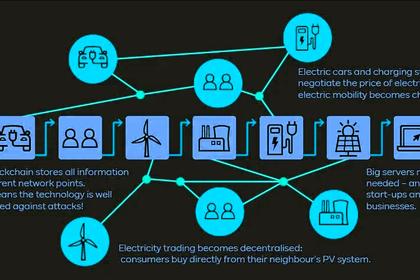
DIGITAL ENERGY TRANSFORMATION

By CONSTANTINOS PEONIDES CEO, MEGGITT
ENERGYCENTRAL- Feb 19, 2024 - Digital transformation in the energy sector offers numerous benefits and opportunities for companies to meet the growing energy demand, particularly from renewable sources. Adapting new technologies and digitization can lead to improvements in various areas, including energy generation, plant maintenance, spare parts management, fuel management, trading, reduced losses, preventive maintenance, retail, and optimized operations.
Digitalization in the energy sector entails automating business processes and workflows, resulting in increased efficiency and cost reduction. By leveraging digital technologies, companies can streamline operations, improve transparency, and enhance customer satisfaction. Digital transformation helps in the development of new products and services, which ultimately adds value for customers and drives business growth.
For investors, asset managers, technical advisors, and O&M service providers in the energy sector, digital strategies are essential. Access to data, technical and operational/financial, is critical for making informed decisions regarding plant/portfolio acquisition, sale, or investment. Digital strategies enable more effective asset management, address personnel changes and knowledge transfer challenges, and ensure transparent and effective operations. Digitalization leads to better management of complex processes, and to meeting customer demands for transparency and scalability.
There are several benefits of digitally transforming an organization in the energy sector:
- Increase competitiveness by eliminating waste and staying ahead in the market.
- Empower a leaner team with the right tools and processes
- Automate manual processes, allowing the team to focus on core competencies.
- Thanks to process automation, Expand the portfolio without necessarily expanding the team.
- Streamline processes and centralize data, enabling efficient reporting and smarter decision-making.
- Easily handle multiple power purchase agreements and automate invoicing.
- Mitigate risks by reducing the likelihood of errors and mistakes.
- Increase return on investment (ROI) by automating operations and reducing costs.
- Achieve meaningful integrated reporting by collecting and centralizing technical, operational, and financial data in a single system, facilitating sharing with stakeholders.
Advanced analytics plays a crucial role in the solar industry too, by leveraging historical data, advanced algorithms, and real-time monitoring to forecast production, predict component failures, and identify potential performance issues. It goes beyond traditional analysis by considering system behavior anomalies and understanding early signs of underperformance. It involves analyzing the behavior of faults over time and projecting the associated losses. This information helps prioritize proactive actions to address potential issues before they lead to significant performance degradation or equipment failures.
By analyzing past data and considering weather and real-time patterns, solar irradiation, and system parameters, advanced analytics provides valuable insights and predictions. This enables the identification of potential issues and allows operators to take proactive measures to optimize system performance and minimize downtime.
You are correct. advanced data analysis involves advanced data processing, correlation analysis, and predictive models to provide actionable intelligence in various aspects such as technical, financial, and economic considerations. It goes beyond simply monitoring and provides deeper insights by identifying patterns, and trends, and offering actionable recommendations.
One important application of advanced analytics is preemptive maintenance planning. By analyzing data from monitoring systems, advanced analytics can identify potential faults or performance issues before they occur. This enables operators to plan and implement preemptive maintenance strategies to avoid costly downtime and optimize system performance.
By leveraging the power of advanced analytics, organizations can improve the efficiency and effectiveness of their preemptive maintenance efforts, reduce costs, and maximize energy generation. The insights gained enable informed decision-making and proactive management of solar assets.
All in all, advanced data analysis helps organizations:
- Focus on Long-Term Decision Making: Asset owners/managers must assess the long-term implications of their decisions, spanning months or even years into the future. This necessitates a forward-looking approach to ensure alignment with overarching goals and objectives.
- Data-Driven Decision-Making: Utilizing data and analytics forms the cornerstone of effective decision-making for asset owners/managers. While intuition and experience play a role, decisions must ultimately be substantiated by empirical evidence and quantitative insights.
- Scenario Planning: Asset owners/managers engage in scenario planning to anticipate various market scenarios and mitigate potential risks. By considering multiple potential outcomes, they can develop resilient strategies capable of adapting to changing environments.
- Agility and Adaptability: Flexibility and responsiveness are essential attributes for asset owners/managers. They must remain agile to swiftly capitalize on emerging opportunities or navigate unforeseen challenges, guided by early warning indicators and proactive risk management strategies.
- Surrounding Oneself with a Capable Team: Building a diverse and skilled team enables asset owners/managers to leverage complementary expertise and perspectives. Collaborative decision-making processes foster innovation and ensure comprehensive evaluations of investment opportunities.
- Effective Communication and Collaboration: Transparent and effective communication is paramount for fostering trust and alignment among stakeholders. Asset owners/managers must articulate their investment rationale and strategies clearly, both internally within their organizations and externally to clients, partners, and regulators.
In summary, the successful stewardship of assets requires a holistic approach that integrates data-driven insights, strategic foresight, and collaborative teamwork, underpinned by clear communication and a commitment to long-term value creation.
-----
Earlier:


















